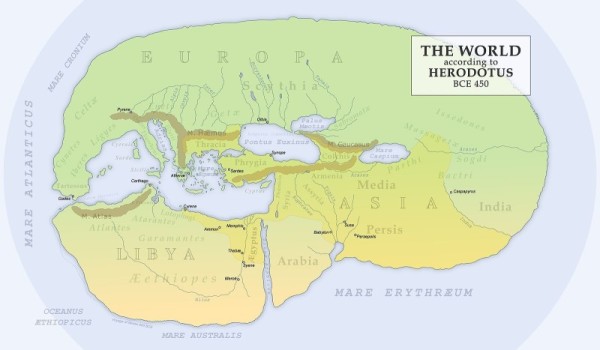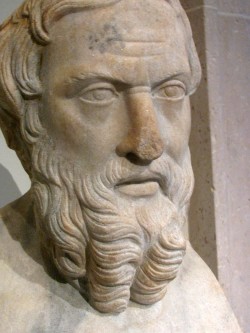However, the belt extends as far as the Pillars of Heracles and also in the parts outside them.

Translated by George C. Macaulay — our special project presenting the complete Herodotus with URLs for all of those people, places, events, and things which baffles and discourages modern readers.
Previously on Herodotus
185. As far as these Atlantians I am able to mention in order the names of those who are settled in the belt of sand; but for the parts beyond these I can do so no more. However, the belt extends as far as the Pillars of Heracles and also in the parts outside them: and there is a mine of salt in it at a distance of ten days’ journey from the Atlantians, and men dwelling there; and these all have their houses built of the lumps of salt, since these parts of Libya which we have now reached are without rain; for if it rained, the walls being made of salt would not be able to last: and the salt is dug up there both white and purple in color. Above the sand-belt, in the parts which are in the direction of the South Wind and towards the interior of Libya, the country is uninhabited, without water and without wild beasts, rainless and treeless, and there is no trace of moisture in it.
186. I have said that from Egypt as far as the Lake Tritonis Libyans dwell who are nomads, eating flesh and drinking milk; and these do not taste at all of the flesh of cows, for the same reason as the Egyptians also abstain from it, nor do they keep swine. Moreover the women of the Kyrenians too think it not right to eat cows’ flesh, because of the Egyptian Isis, and they even keep fasts and celebrate festivals for her; and the women of Barca, in addition from cows’ flesh, do not taste of swine either.
187. Thus it is with these matters: but in the region to the West of lake Tritonis the Libyans cease to be nomads, and they do not practice the same customs, nor do to their children anything like that which the nomads are wont to do; for the nomad Libyans, whether all of them I cannot say for certain, but many of them, do as follows: when their children are four years old, they burn with a greasy piece of sheep’s wool the veins in the crowns of their heads, and some of them burn the veins of the temples, so that for all their lives to come the cold humor may not run down from their heads and do them hurt: and for this reason it is (they say) that they are so healthy; for the Libyans are in truth the most healthy of all races concerning which we have knowledge, whether for this reason or not I cannot say for certain, but the most healthy they certainly are: and if, when they burn the children, a convulsion comes on, they have found out a remedy for this; for they pour upon them the water of a he-goat and so save them. I report that which is reported by the Libyans themselves.
188. The following is the manner of sacrifice which the nomads have: they cut off a part of the animal’s ear as a first offering and throw it over the house, and having done this they twist its neck. They sacrifice only to the Sun and the Moon; that is to say, to these all the Libyans sacrifice, but those who dwell round the Lake Tritonis sacrifice most of all to Athene, and next to Triton and Poseidon.

CC BY-SA 2.0 image from Wikipedia.
189. It would appear also that the Hellenes made the dress and the aigis of the images of Athene after the model of the Libyan women; for except that the dress of the Libyan women is of leather, and the tassels which hang from their aigis are not formed of serpents but of leather thongs, in all other respects Athene is dressed like them. Moreover the name too declares that the dress of the figures of Pallas has come from Libya, for the Libyan women wear over their other garments bare goat-skins (aigeas) with tasseled fringes and colored over with red madder, and from the name of these goat-skins the Hellenes formed the name aigis. I think also that in these regions first arose the practice of crying aloud during the performance of sacred rites, for the Libyan women do this very well. The Hellenes learnt from the Libyans also the yoking together of four horses.
190. The nomads bury those who die just in the same manner as the Hellenes, except only the Nasamonians: these bury bodies in a sitting posture, taking care at the moment when the man expires to place him sitting and not to let him die lying down on his back. They have dwellings composed of the stems of asphodel entwined with rushes, and so made that they can be carried about. Such are the customs followed by these tribes.
191. On the West of the river Triton next after the Auseans come Libyans who are tillers of the soil, and whose custom it is to possess fixed habitations; and they are called Maxyans. They grow their hair long on the right side of their heads and cut it short upon the left, and smear their bodies over with red ochre. These say that they are of the men who came from Troy.
This country and the rest of Libya which is towards the West is both much more frequented by wild beasts and much more thickly wooded than the country of the nomads: for whereas the part of Libya which is situated towards the East, where the nomads dwell, is low-lying and sandy up to the river Triton, that which succeeds it towards the West, the country of those who till the soil, is exceedingly mountainous and thickly-wooded and full of wild beasts: for in the land of these are found both the monstrous serpent and the lion and the elephant, and bears and venomous snakes and horned asses, besides the dog-headed men, and the headless men with their eyes set in their breasts (at least so say the Libyans about them), and the wild men and wild women, and a great multitude of other beasts which are not fabulous like these.
– Herodotus, Book IV
| <—Previous | Master List | Next—> |
Herodotus made his living by being interesting. In a world where most people did not read and could not afford to buy a book even if they could, they would pay to listen to Herodotus recite from his books. They would not pay to be bored. In that world, the names that populate his stories would have some general familiarity to his audience. Their obscurity to us is a barrier that this series seeks to break down.
MORE INFORMATION
MAP LIBRARY
Because of lack of detail in maps as embedded images, we are providing links instead, enabling readers to view them full screen.

Leave a Reply
You must be logged in to post a comment.